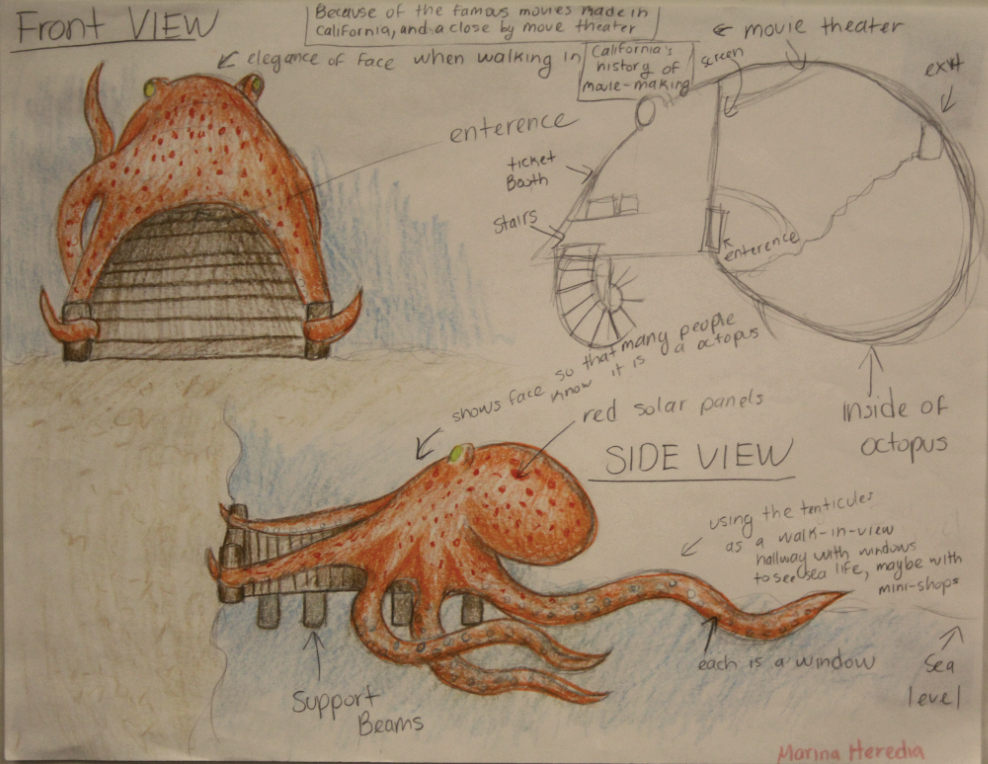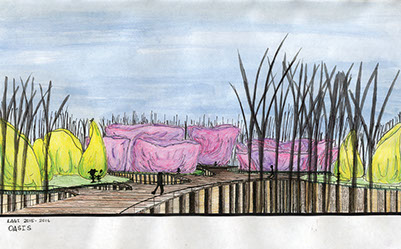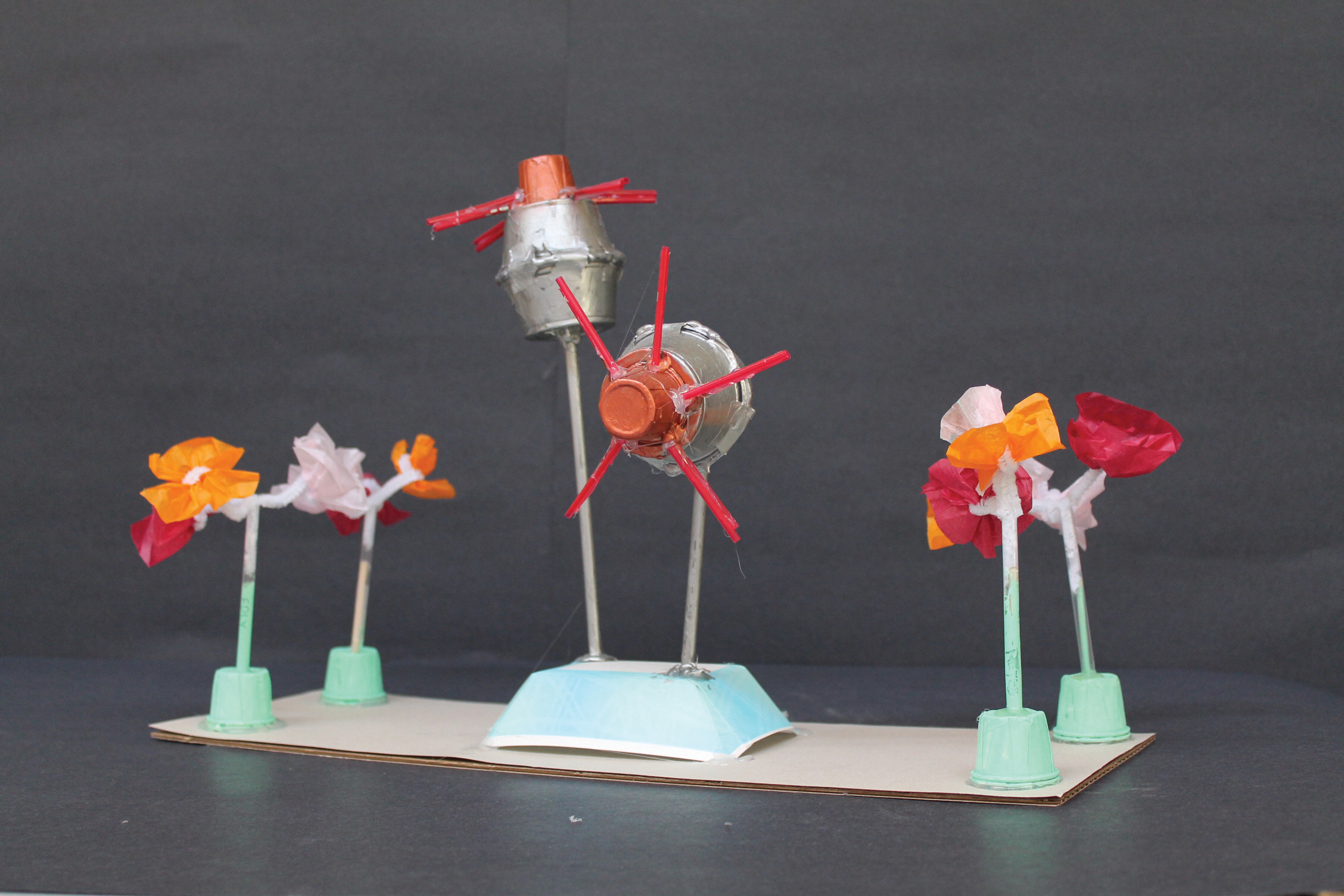Above is a small sampling of the many submissions to the Youth Prize
LAGI 2015–16 Youth Prize
According to a recent report highlighted by the World Economic Forum*, as automation continues to change the workplace, the highest valued skills are increasingly dominated by creativity, critical thinking, complex problem solving, cognitive flexibility, and emotional intelligence— all qualities that require the arts to be integrally interwoven into the fabric of our lives.
Providing STEAM education to high school students using the Arts as the delivery vehicle is an engaging way to instill an early interest in the scientific method, provide useful technical skills, and introduce systems thinking. Project-based learning can help students think creatively about design challenges in order to find innovative solutions.
With these thoughts in mind, and building off of the educational materials from past LAGI competitions, we launched a Youth Prize to coincide with the LAGI 2016 professional competition.
In addition to a custom Youth Prize design brief, we provided a 13-step Toolkit of activities that teachers and students could use to take them through the entire design process for the development of a land art generator for a site next to the Santa Monica Pier.
Entering a world already grappling with the issue of climate change, the high school students of today will be leading the design of our energy solutions of tomorrow. Through LAGI, we want to nurture a global community of young people equipped to design our new energy landscapes. The process of imagining renewable energy as artwork for public spaces is a great way to inspire young people to want to learn more about energy science and engineering.
The Youth Prize was open throughout the 2015–2016 school year, allowing classrooms to integrate the project into their curriculum. We were delighted by the embrace of the Toolkit by teachers and administrators, and the way that cross-disciplinary collaborations within schools brought teachers from many different subjects together for the challenge.
It was a pleasure to be able to speak in person at schools or video conference into classrooms to provide feedback and answer questions about the design brief. We’re looking forward to continuing and expanding on the Youth Prize Toolkit in the years to come.
For more information, see
http://youth.landartgenerator.org










The Octopus’s Garden, 1st Place Winner, 2015–16 LAGI Youth Prize
TEAM: Marina Heredia, Leo Mei, Raul Chavez, Michael Wood, Shanti Davis
Energy Technologies: flexible solar thin-film, wind turbine, solar pond, point absorber wave energy, converter
ANNUAL CAPACITY: 2,600 MWh
HIGH SCHOOL: Quartz Hill High School,
Antelope Valley Union High School District
TEACHER: Deepak Dhillonn
The Octopus’s Garden is inspired by the California two-spot octopus. Around the artwork four unique habitats house eleven species that are indigenous to the Santa Monica Bay.
As visitors make their way from the beach and into the geodesic dome (the octopus’s mantle) they are greeted with two cephalopod arms, each wrapped around a conch shell with a wind turbine inside. Once in the dome, the visitors discover a museum with information about local marine life. From there, they make their way to a viewing deck where they can look out to the horizon beyond the six other arms of the octopus.
On the surface of the octopus and along the boardwalk, translucent solar panels convert sunlight into electricity. The skin of the structure also heats up water that is fed into a solar pond. A Rankine cycle turbine uses the difference in temperature between the cold ocean water and the warm solar-heated water to generate additional electricity. Along the free-floating arms of the octopus, wave energy converting buoys also make electricity while the waves appear to give life to the creature.
Most of the energy from these systems is fed into the city’s grid, but some is used to illuminate the land-side end of the octopus, mimicking the natural bioluminescence of some cephalopod species.
The end curls of the sea-side arms create micro-environments ideal for various species. Four arms contain rocks, kelp forests, and coral reefs. The last two arms house a rocky environment with eight species: two-spot octopus, round stingrays, California mussels, Norris top snail, bat star, ochre sea snail, sea urchin, and sand dollar. The furthest arm contains a kelp bed for kelp crab, club tipped anemone, and tube dwelling anemone. The curl of the closest arm contains a coral reef for sea stars such as the brittle star.
TEAM: Fields of Golden Sun: The Eco Poppies, 2nd Place Winner,
2015–16 LAGI Youth Prize
Austyn Adams, Jandy Alegre, Steven Aguilar, Ricardo Guzman, Blanca Zepeda, Fernando Martinez, Savannah Fournier, Daniel Ramirez, Lucas Lescano, Alexis Lorenana, Genesis Aquino, Jonathan Pinedo
Energy Technologies: thin-film solar, kinetic wind harvesting,
point absorber wave energy converter
ANNUAL CAPACITY: 2,500 MWh
HIGH SCHOOL: Palmdale High School,
Antelope Valley Union High School District
TEACHER: Steven R. Calzada
Fields of Golden Sun is an expanse of California poppy flowers, a symbolic representation of Southern California and a familiar, recognizable, and playful form. This land art generator harnesses solar, kinetic, and tidal energy to help power existing needs such as the adjacent Santa Monica Pier. The flowers on the beach transform into water lilies as they work their way out into the surf. A walkway leads visitors through this transitional space and out into the ocean. The land-side poppies incorporate solar panels into their petals and generate additional energy by harvesting the back-and-forth movement of the stalk as it sways gently in the wind. The water lily generators utilize wave energy, taking advantage of the never-ending motion within the Pacific Ocean waters.
Along the walkway are places for visitors to rest and relax, and enjoy the shade and movement created by the poppy structures. At night the poppies are illuminated by LED lights placed along the stem and leaves.
Process note: The design began with drawings and sketches in various mediums created by the art department students. The ideas were then re-created in large sheets of cardboard, which were used as a platform for placing small solar panel cells so that we could learn what type would make the best choice for our design. Design and engineering students took the sketches and models and made the designs come to life using computer graphics and 3-D modeling programs to create digital renderings. Along the way, math, geometry, and physics students challenged the design while taking care to understand the correct incident angles for solar panel energy capturing.
Oasis, 3rd Place Winner, 2015–16 LAGI Youth Prize
TEAM: Hanna Wells, Sagar Kamath, Gabriel Tobias
Energy Technologies: flexible solar thin-film, piezoelectric stacked actuators (similar to Windstalk from LAGI 2010),
point absorber wave energy converter
ANNUAL CAPACITY: 2,000 MWh
HIGH SCHOOL: Creative and Performing Arts (CAPA) Magnet,
Pittsburgh Public Schools
TEACHER: Allan Finch
Imagine spending a day by the ocean—walking along a boardwalk, engulfed in the morning mist of the salty air, and seagulls above. The boardwalk leads to a garden. Stepping into this wonderland, the atmosphere becomes more serene, with blossoming flowers and swaying grass. The path continues to weave through the hazy field of colors, as the flowers become increasingly monumental. At the end of the path lies an open flower, a gigantic blossom.
Oasis is a garden on the beach, inspired by nature and the beauty of Santa Monica. Reflecting the natural world, it invites visitors to question their own relationship with nature and the environment. The largest flowers along the boardwalk and the flower floating at the terminus are California poppies. The crocus is the model for the smaller flowers and the medium-sized petals mimic the anemone. An arrangement of benches and a central platform creates a “flower pavilion” for street performers or family picnics.
The petals of the flowers slant toward the south in order to create maximum energy from their flexible thin-film solar panel surfaces. The “grass” of Oasis is constructed from Windstalks—modeled from the design of a 2010 LAGI competition submission by Dario Nuñez Ameni and Thomas Siegl. The largest flower at the end of the boardwalk is designed to float up and down with the waves, constantly converting hydrokinetic energy into electricity.
Beginning at dusk, the flowers of this energy bouquet glow gently to create a perfect nightlife atmosphere.
Solar Octopus, a submission to the 2015–16 LAGI Youth Prize
TEAM: Aidan Ray
Energy Technologies: tinted solar panels, wind turbines
ANNUAL CAPACITY: 500 MWh
HIGH SCHOOL: City Charter High School, City Charter High School District
Solar Octopus is a larger-than-life sculpture of the California two-spot octopus set close to the shore and best viewed from the Santa Monica Pier. The artwork is roughly ten feet tall and almost completely covered in orange solar panels, with the exception of the bottom and the eyes of the octopus. Additional electricity is generated by four small wind turbines, which are placed within the two front arms of the octopus, resembling suckers.
The message of the artwork is that nature is important and a key part of our survival. The actual two-spot octopus along with other sea creatures help sustain the environment just as the sculpture will provide sustainable energy to help power the pier.
Music of the Wind, a submission to the 2015–16 LAGI Youth Prize
TEAM: Edly Reyes, Daniel Estrada, Dylan Cabanlit
Energy Technologies: thin-film photovoltaic, wind turbine
ANNUAL CAPACITY: 1,200 MWh
HIGH SCHOOL: Eastside High School,
Antelope Valley Union High School District
TEACHER: Evelyn Rivas
Visitors to this art installation adjacent to the Santa Monica Pier delight in the magical wonder of this energy landscape. There is an equalizing effect on the people walking through the artwork—everyone is dwarfed by the scale of the flowers, which call to mind scenes from a Lewis Carroll story.
Each flower is made using colorful thin-film solar materials that feed electricity into the city grid. With some of the stored energy collected during the day, the flowers come to life at night, illuminating the beach with a rotating array of colors and sounds. The sound and light reflect the direction and the strength of the wind. The central wind turbines have the dual benefit of generating electricity while also desalinating ocean water for use in fountains on site.
<
>
